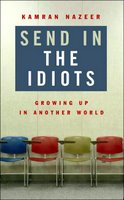>
When I read Kamran Nazeer’s Send in the Idiots: stories from the other side of autism, I read from the point of view of a mother wondering about the future for my high-functioning autistic teen. At first, I made mental notes about how the young adults in the book related to others. Their living arrangements, their interactions, and their friendships all filed themselves dutifully in my head. Andre, living with his sister: a young man who communicated with puppets and became infuriated when someone dared to interrupt. Randall: quiet, a good listener, involved in a monogamous relationship with a non-autistic person. Craig, who lived alone but welcomed guests. Elizabeth, a young woman who lived mainly with her parents but spent some of her late teens and early twenties residing in an inpatient facility for mentally ill, dealing with epilepsy and bipolar disorder in addition to autism.
Then Nazeer said that half of all autistic adults live with their parents, and my mind turned around. Half? Does he mean all autistic adults, no matter where they are on the spectrum? And since he quoted no specific source, is this statistic accurate? Frankly, it worried me more than a little.
Nazeer, who lives alone, talks about his frequent contacts with his parents, and their “…enhanced duty of care…” balanced with the “…joy that I have my independence.” (p.171)
Built into parenting is the expectation that our children will grow up, become independent, and live productive, happy lives. Suddenly that picture is blurry for me, like those optical challenges where by using a slightly unfocused stare you can see a different image emerge. The image for my 14 year old son will be somewhat different from that of a non-disabled, non-autistic person. Somehow, someway, a new image will emerge from the blurry pattern.
Nazeer talks about many other elements of autism such as the need for local coherence and challenges in language development. He also describes a meeting with his former teacher and his former counselor/therapist. I did not discuss these, but they are worthwhile parts of the book. I recommend this book to people dealing with autism, especially parents and professionals who work with families. It is an easy read and will stimulate discussion and thought.

>I’m still trying to figure out just the right angle to look on Charlie’s world…….. The book is still on my mind, for the very reasons you describe here.